| Published
on 14
Jun 2017 |
All rights reserved.
|
|
|

|
|
Similar
to Lexus LFA, the new Ford GT offers Ferrari and McLaren-level of
performance, but costs double the price!
|
|
Until the 1990s, we called
the fastest, maddest
and most exclusive mid-engined sports cars as Supercars. Even though Porsche 959
and Ferrari F40 lifted the game higher again, they were still called
supercars, the same as Ferrari Testarossa or Lamborghini Diablo.
McLaren F1 was supercar again, ditto Jaguar XJ220, Bugatti Veyron…
Strangely, these few years people suddenly call a Ferrari
458 as Supercars. The same goes for the small Lambo, Audi R8 or
even the good old 911 Turbo that has been existing since 1975! Yes,
they get even more powerful than yesterday’s supercars, but that is the
way technology progresses, isn’t it? A 1954 Mercedes 300SL had only
215hp, but will you call today’s 245hp SLC300 as Supercar? Of course
not! As time goes by, the standard should be lifted as well. In my
opinion, Supercars always denotes the ultimate
mid-engined sports cars. New terms like "Hypercars" should be shelved,
otherwise you will need "Ultracars" not long later to denote the even
faster cars available then, and then you will run out of terms.
So here in AutoZine, the likes of Ferrari 488GTB and Lamborghini
Huracan are called Junior Supercars
instead. Just a few years ago, the two Italian marques were the only
contenders in a class of their own. Today, you will find
many other alternatives – McLaren 720S and Honda NSX are the most
direct rivals, but you may also count the slightly cheaper Audi R8 V10
Plus, 911 Turbo S, 911 GT3 RS and AMG GT R. If not already ran out of
production, Lexus LFA would have been an interesting rival as well – it
had adequate performance and handling to fight against the Italian
exotics, but it cost double the price!
The new Ford GT has a market positioning similar to the LFA.
Performance-wise, it is right in the ballpark of 488GTB, 720S or
Huracan Performante, but it asks for an absurd $450,000 in its home
market, or £450,000 plus tax in UK, compared with £183K
after tax for the Ferrari, £209K for the McLaren or £213K
for the Lamborghini. And this is from a company making your Fiesta,
Focus or F-150 pickup! Who can swallow that? Strangely, among the 1000
cars slated for production in the next 4 years, 750 of them have
already found buyers, and the rest are likely to be spoken for by the
time you have finished reading this sentence. Sometimes I think the
exotic car markets have gone too crazy! There are too many people
having too much money, and not enough people care about the poverty.
 |
|
It
is designed to be a race car in the first place, then
reverse-engineered to be a road car for sale...
|
|
You must remember the last, 2003 Ford GT.
It was very much a GT40
reinterpreted as a modern road car. The new GT
is very different. It is designed to be an endurance race car (mainly
the GTE-Pro class of Le Mans and IMSA) in the first place, then
reverse-engineered to be a road car for sale. This sounds like the
Group B era, but the Le Mans and IMSA regulations are much looser,
allowing the car to be raced first, then road car production follows.
In this way, the new Ford GT won the Le Mans GTE-Pro class last June,
but the first customer car was not delivered until very recently.
Thanks to the lack of tight schedule, the road car development could be
done properly, so it does not have the quality problems of Group B
cars.
Interestingly, the development story of this car sounds like a
carbon-copy of Jaguar XJ220's. In the late 1980s, a dozen of Jaguar
engineers and designers used their spare time after office hours to
start the XJ220 project. As they usually held meetings on Saturday,
they were dubbed the “Saturday Club”. At Ford, the situation is
slightly better. Ford Performance, the racing department, originally
wanted to develop the Mustang into a GTE race car, but it realized that
winning was a mission impossible without designing a brand new
mid-engined car. Without getting the permission of the top management
(i.e. Alan Mulally and Mark Fields), it gathered about 20 designers,
modellers and engineers to work on the new car secretly. They worked in
a locked
basement and held meetings only after working hours and on weekends to
avoid suspicion. The rest is history. No wonder when the car was
unveiled in Detroit motor show in 2015, it caught everyone a surprise.
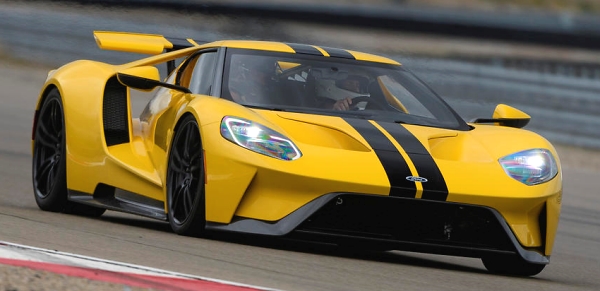
|
|
Front
end has strong family resemblance to GT40, but the rest is driven by
aerodynamics, more so than any road cars in memory.
|
|
The GT has a very exotic look, more so than Ferrari or Lamborghini
perhaps,
even more aggressive than the new McLaren 720S, especially its
aerodynamic design. It is extremely wide at over 2 meters, obviously
designed for track performance rather than
roadability. It is also extremely low. In road condition, it is only
43.7 inches (1110 mm) tall, a full inch lower than Lamborghini
Aventador or everything else in production. When Track mode is
selected, its suspension will drop a further 50mm, and the car's height
becomes 41.7 inch. Not quite a new GT40, but it is as close as you can
get in a modern car.
Viewing from the front, the GT has strong family resemblance to the
original GT40, but the rest of the car is driven by
aerodynamics, more so than any road cars in memory. Like a Le Mans car,
its passenger cell is very narrow – impossibly narrow for a 2-seater –
and it gets slimmer as it extends towards the tail. As a result, the
rear wheels are separated from the main body by a huge channel,
allowing air to flow straight to the rear wing,
improving drag and downforce. Meanwhile, the radiators of intercoolers
are mounted outboard just ahead of the rear wheels to take advantage of
clean air flow. A flying buttress bridge between the roof and each rear
fender for reinforcement and improving aesthetic. Overall, the new GT
looks edge-cutting sharp, impossibly low, wide and long. It is a
stunning design, although not necessarily a beautiful design in
conventional sense.
Undoubtedly, its smallish frontal area and the aforementioned air
channels give it a
strong advantage on track, no wonder it won Le Mans straightaway
against its road car-based Ferrari, Aston, Porsche and Corvette rivals.
Also
helpful are flat underbody and active aerodynamic aids. Underneath the
front overhang are 2 movable flaps, which can be raised and guide the
underfloor air flow to pass over the suspension’s lower control arms
and exit through the side vents just behind the front wheels. This
creates ground effect and generates downforce. Meanwhile, the
hydraulic-actuated rear wing not only rises and tilts, but it also
incorporates movable foils at its trailing edge to alter the profile of
the wing. For top-speed run, the rear wing and suspension are lowered,
reducing drag coefficient to 0.35 – sounds unremarkable, but don’t
forget this is a track car.
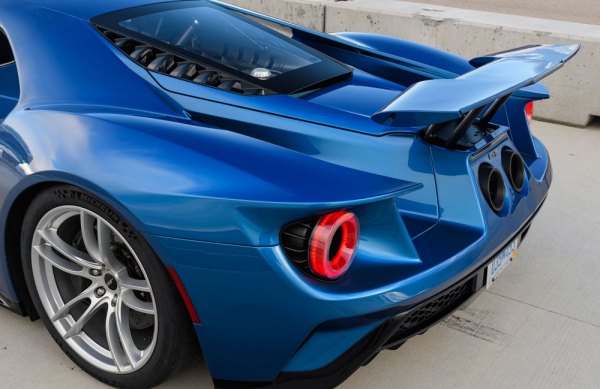 |
|
The
rear wheels are separated from the main body by a huge channel,
allowing air to flow straight to the rear wing, improving drag and
downforce.
|
|
While the car’s design and early development was carried out in-house,
detailed development of the chassis and handling was assigned to
Canadian engineering and motorsport firm Multimatic. In fact,
Multimatic is half the parents of the car, as it is also responsible
for its assembly and running its GT racing program. You might remember,
Multimatic built the carbon-fiber chassis of Aston Martin One-77, so it is
not a surprise that the GT employs its carbon-fiber tub, completed with
steel rollcage (which meets FIA standards) and front and rear aluminum
subframes. All outer body panels are carbon-fiber, unlike Ferrari and
McLaren which use primarily aluminum skins (also chassis in the case of
Ferrari). This partly explains its high price, but it also implies
costly repair in case of damage.
However, what makes the GT like a race car is its suspension. It is the
only car in its class to employ inboard-mounted springs and dampers,
operated via pushrods and very long forged double-wishbones in each
corner. Supercars like Koenigsegg, Pagani or Lambo Aventador have
similar features, but they use it for reducing height or unsprung
weight. Instead, the Ford GT uses it to make space for the
aforementioned air channels between the rear wheels and main body.
Another novel feature is DSSV (Dynamic Suspension Spool Valve) dampers,
which are also made by Multimatic (what a multi-talented company!). It
is known for the capability of fine tuning. The last Chevrolet Camaro Z/28
also used DSSV dampers, but on the GT, it is electronically instead of
manually adjustable. Furthermore, the GT’s suspension is adjustable for
2 ride heights. To that end, it employs 2 springs each corner – one
coil spring and one torsion bar. When Track mode is engaged, the coil
spring is hydraulically compressed and locked, dropping the ride height
by 50mm while doubling the spring rate. It sounds like McLaren P1 but
implemented by different means.

|
|
The
suspension features 1 coil spring and 1 torsion bar (both green), while
damper is DSSV (blue). Flat wishbones are wind cheating.
|
|
As for engine, I would be happy if Ford made a turbocharged version of
its high-revving V8 on Mustang GT350, but when the target is to make
the most of Le Mans regulations, which caps the output at 500hp, a V6
turbo seems to be more sensible in terms of weight and packaging. Ford
found its existing 3.5-liter direct-injection twin-turbo provides the
best package, as its 60-degree angle fits nicely into the narrow engine
compartment. Ridiculously, the unit is based on the one employed by
F-150 Raptor, with 60 percent parts shared. However, it is converted to
dry-sump lubrication to lower its center of gravity and keep oiling
effective at high g-force. Most of the internals have been replaced
with better components. The fuel injection incorporates both direct and
port injection. Maximum turbo boost pressure is unknown, but it should
be very high, as its specific output of 185hp/liter is even higher than
those of Ferrari 488GTB (171hp/liter) and McLaren 720S (180hp/liter) !
As for absolute figure, its 647 hp output trails the Ferrari's 670 hp a
little, if some way off the new McLaren's 720 hp.
On the downside, the maximum horsepower of the Ecoboost V6 happens at
an unexotic 6250 rpm, and it won’t spin beyond 7000 rpm, a full
thousand revs lower than its rivals. Meanwhile, the maximum torque of
550 lbft comes a little late at 5900 rpm, although the company claims
90 percent of that, or 495 lbft, is available from 3500 rpm. Hey, the
Ferrari V8 delivers its full 560 lbft from 3000 rpm! Anyway, this is
the most powerful 6-cylinder engine in the world until the forthcoming
Porsche 991 GT2 RS. While it is out-cylindered by its rivals, it
reminds
us the late Jaguar XJ220, which also employed a 3.5-liter V6 twin-turbo.
To address turbo lag issue, Ford gives it a so-called “anti-lag”
function. Although it did not elaborate, normally this term means when
you back off briefly, the engine will keep the throttle butterfly
opening but cut
fuel and ignition, so that air will continue to pass through the
combustion chambers and keep the turbine spinning until you re-engage
throttle. Mind you, Porsche has a similar feature called “Dynamic
Boost” in the 991.2 Turbo. In Ford GT, the anti-lag is said to reduce
the response time at 3000 rpm from 1.2 to 0.7 second.
 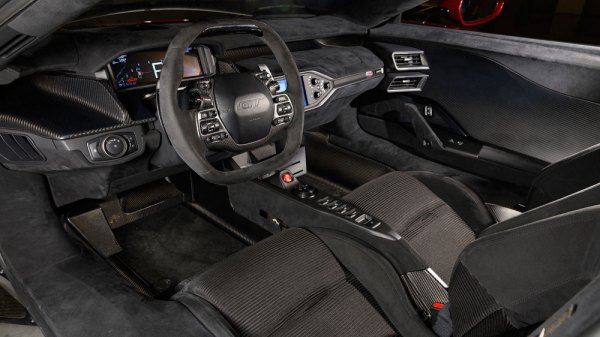
|
|
V6
turbo is chosen to fit Le Mans regulations. Cockpit is cramped.
|
|
Power goes through a Getrag 7-speed twin-clutch gearbox (the same as
Ferrari’s) and a Torsen LSD to the rear wheels. Sadly, there is no
active diff, so it is not going to do sideway as deliberately as
Ferrari. As a track car, the GT focuses on cornering grip and speed
instead of counterproductive slides. To that end, it wears Michelin
Pilot Sport Cup 2 rubbers with immense sizes – 245/35ZR20 front and
325/30ZR20 rear, the latter is 20mm wider than its Ferrari and McLaren
counterparts. As expected, braking power comes from standard Brembo
carbon-ceramic brakes, with 6-piston calipers serving 394mm discs up
front and 4-piston calipers clamping 360mm discs at the rear.
A little bit disappointing is the dry weight of 1385 kg, which
is 15 kg more than the figure quoted by 488GTB (although Ferrari is
usually optimistic) and a massive 102 kg heavier than
McLaren 720S. Moreover, this is already the car fitted with
“Competition pack”, which has the air-con, infotainment, audio and
cup-holders ditched, the glass engine window replaced with plexiglass,
the rear bulkhead window replaced with lighter Gorilla glass, and
fitted with
expensive carbon-fiber wheels and titanium exhaust. The regular
road-going GT weighs a further 60 kg. For a car with carbon-fiber
chassis and
skins and a V6 engine instead of V8, it is difficult to explain. Still,
Ford claims a class-leading top speed of 216 mph, while 0-60 mph is
expected to be inseparable from its rivals.
On the Road
The GT’s cockpit is as difficult to access as those of old-school
supercars. It has butterfly doors, but they don’t open the roof like
McLaren 720S, so the door apertures are small and you have to cross the
very wide sills to drop into the seats. To let them mounted lower, the
seat cushions are fixed to the carbon-fiber tub like LaFerrari, but the
backrests are not, and they can be adjusted for rake. The pedal box and
steering wheel are manually adjustable to suit different driver sizes.
Once you are in place, you will find how cramped this cockpit is – it
is as narrow as Lotus Elise, so you have to rub shoulders with your
passenger, while headroom is even tighter than Lotus. It won’t fit guys
over 6ft 2in, blame to the ultralow roof. Naturally, the cockpit feels
quite claustrophobic. Front view is good, but side, rear quarter and
rear views are limited. Despite exposed carbon-fiber and Alcantara
everywhere, the interior design is more functional than attractive. You
will also notice some switchgears and buttons sourced from Ford’s parts
bin. The steering wheel is overcrowded with buttons, but unlike
Ferrari, without Magnetino-style rotary switch for easy access to
driving modes. In terms of luggage space, what luggage space? There is
only a laughable 11-liter storage compartment located between the
engine and the exhaust. Yes, 11 liters, not 110 liters. Not
sure if it is enough for a crash helmet.
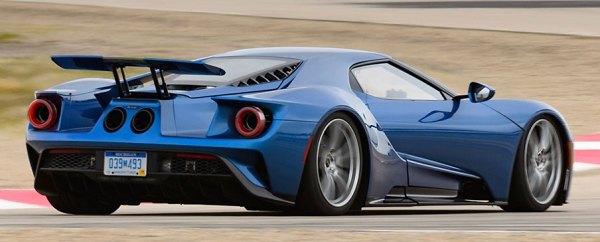
|
|
It
combines the ride of a proper road car and the handling of a track
car...
|
|
Fortunately, the GT is built to drive, not to carry. Start the V6, at
first you will be disappointed with an exhaust note that sounds gruff
and industrial. Not unlike an F-150 actually. Give it more work to do
and its soundtrack improves gradually. In Sport and Track mode where
anti-lag function is activated, the turbos show little lag, a
remarkable achievement for such a highly boosted engine. Throttle
response is quick, too. The power delivery is more linear than many
other turbocharged rivals, as there is no explosive mid-range to shock
you. It feels stronger from 3000 rpm, and then a second kick comes at
5500 rpm. From there to the 7000 rpm redline is its show time. Is it
fast? Yes, but probably not as punchy as its Ferrari or McLaren rivals.
No one has measured its real-world performance yet, but I guess it will
do 0-124 mph in high-8-seconds range, whereas 488GTB and 720S manage in
8.3s and 7.8s respectively. Near the upper end of its rev range, the
noise is certainly more interesting than that in idle, but still it is
more business-as-usual than sonorous, or lacking the angry bark of some
rivals. Admittedly, V6 is not a good layout for sound quality.
The Getrag 7-speed twin-clutch gearbox is good. Upshifts are lightning
quick and downshifts are well matched with revs. However, Ferrari’s
gearshifts feel a tad more incisive. Mind you, the race car employs a
single-clutch sequential box instead. Maybe it is why the road car
didn’t spend enough time to fine tune its mapping like Ferrari.
On public roads, the GT also feels a tad slower than its rivals given a
long stretch of straight. On the plus side, its suspension rides
surprisingly comfortable in Normal mode. Not quite as supple on rough
surfaces as the hydraulic-suspended McLaren, but its body is better
controlled, showing superior composure and lack of roll in corners. It
combines the ride of a proper road car and the handling of a track car,
which is perhaps its biggest achievement. It feels remarkably agile and
willing to turn. The hydraulic-assisted steering is fast (2.5 turns
lock-to-lock), linear, weighty and accurate, if not the most feelsome.
The fat Cup tires produce phenomenal grip. On public roads, the car
just steers as you point, without understeer or oversteer to speak of.
Its cornering limit is so high that you will need a track to overstep.
The only real weakness is braking. While it is powerful, the brake
pedal feels soft at the top of its travel, so under light loads it is
quite difficult to modulate smoothly.
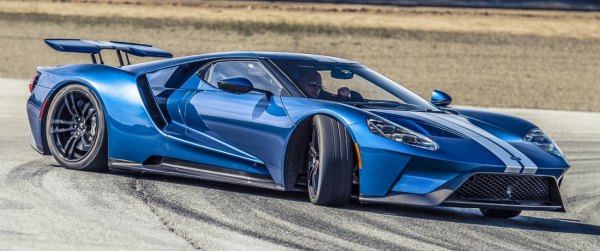 |
|
Without
an e-diff, you need to be smooth with your inputs, just like a racing
driver should, and the car will obey your commands precisely.
|
|
On the downside, the car does feel too wide for public roads. You are
always aware of its width and therefore difficult to exploit its
handling as hard as it could. Passing through single-lane country roads
will need special care not to touch the opposite cars. In terms of
refinement, unfortunately, the good ride quality is offset by high
noise level. After all, this is pretty much a car designed for racing
in the first place, so its sound insulation and NVH engineering are
scarce. Its cabin is filled with all sorts of noises and vibrations –
wind, tire, resonance from the exhaust at certain revs, the shocks when
the rear wing is raised or lowered, the odd noises when something hits
the bottom of the car, steering kickback on rough surfaces… At 70 mph,
the cabin is so loud that you need to shout to your passenger. Besides,
the high fuel consumption limits its traveling range, and the lack of
luggage space means cross-country travel would not be an option. All
these mean the Ford GT is not a very good road car, unlike the 2003
model.
However, the GT is born for track. Its low ride height in Track mode,
its superior grip, balance, composure and agility make it hard to be
beaten by any road-legal machines – it will be interesting to see how
it is compared with McLaren 720S. Its linear power, which might feel
undramatic on highway, becomes a great companion for attacking corners,
flowing from one to another. Here on track you can push the car so hard
to reveal its slight understeer at the limit. Feed more power and it
will run gently into oversteer. Lift the throttle abruptly in fast
corners will tighten its line. Without an e-diff, you need to be smooth
with your inputs, just like a racing driver should, and the car will
obey your commands precisely. Applying throttle too aggressively could
slide its rear and trigger the electronic safety net to intervene, but
this is still a car rewarding smooth, measured driving style. A 911 GT3
or Ferrari 488 would be more forgiving and more entertaining to abuse
on track, but the Ford is certainly faster and more precise. In other
words, more like a race car.
That is not a bit surprise to us though.
|
Verdict:     |
|